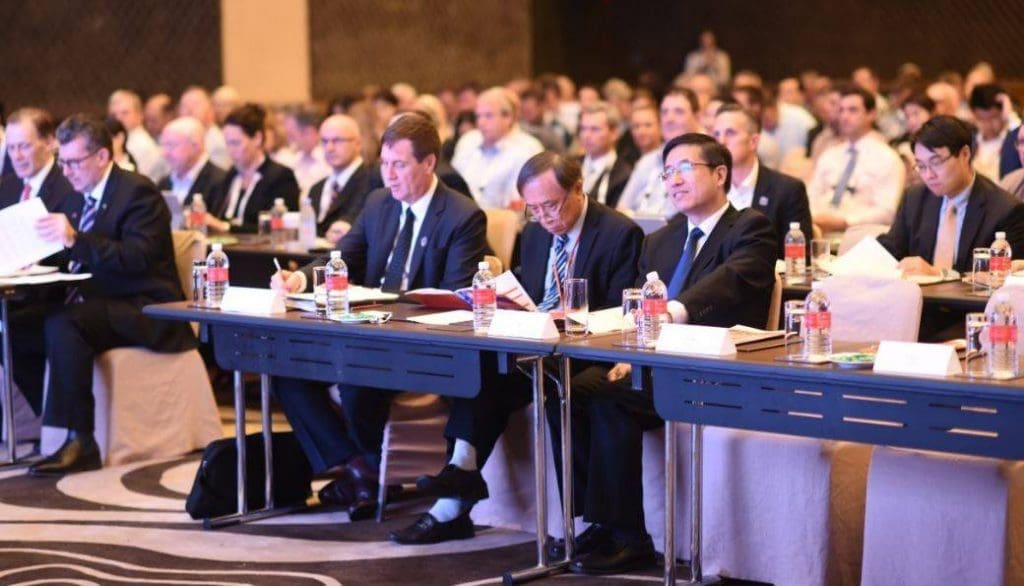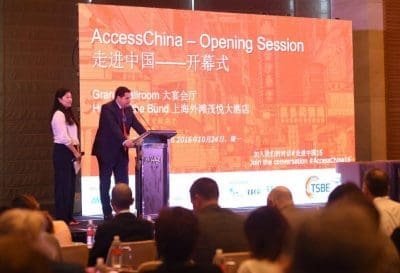
About 300 Australian and Chinese delegates gathered at the Access China conference in Shanghai this week. Picture: Toowoomba Surat Basin Enterprise
Further Chinese investment in the Australian red meat supply chain is one of the keys to speeding-up progress in lowering technical trade barriers for Australian beef aiming to access the Chinese export market.
That was a consistent message from a number of speakers involved in yesterday’s Toowoomba and Surat Basin Enterprise Access China conference in Shanghai.
Slow pace of reform
The glacial pace of reforms in China trade in areas like chilled beef access was a source of frustration for some Australian red meat businesses and other stakeholders represented at the conference.
But strategic alliances or investment in assets in Australia could help, several speakers suggested.
Elders China chief executive Craig Aldous told the gathering that despite the signing of the China Australia Free Trade Agreement a year ago, there was still a long list of agricultural products that were still unable to enter the China market.
“Much more needs to be done to solve these access issues,” he said.
“The best way to speed-up this process is to encourage Chinese investment in key sectors of the Australian (agricultural) economy,” Mr Aldous said.
“For a product (like chilled beef) where access is currently restricted into China, if a Chinese investor acquires or invests in a business in Australia that is exporting that product to other markets, then the chances of it getting access are dramatically improved,” he said.
An example Beef Central is aware of is WA beef and sheepmeat processor V&V Walsh, which entered into a joint venture with a Chinese partner several years ago. V&V Walsh remains the only processor of sheepmeat in Australia eligible to export chilled lamb to China. Stakeholders say that is more than coincidence.
Assistant trade minister Keith Pitt, who opened this week’s TSBE Access China trade conference, was somewhat evasive about trade reform priorities for Australian ag products into China, when pressed on the matter during a conference media briefing yesterday.
Tasked earlier this month with the role of addressing non-tariff trade barriers to Australian agricultural exports, Mr Pitt refused to acknowledge that beef issues like chilled access or live feeder cattle were a priority for the government.
“I’m well aware of a number of challenges we’ve had in importing countries for agricultural products,” he said.
“We continue to work on those, and certainly there is support within Federal government to work back through Austrade and other channels to get better market access… but I don’t want to pick favourites,” he said.
“But of course we will be working through a priority list, based on continuing discussions with industry representatives. A number of commodity groups have come through with their list of the most challenging and difficult non-tariff barriers.”
FTA has delivered some ‘real success’: Pitt
Asked if he was frustrated at the pace of change in trade reform since the China FTA was activated, Mr Pitt said there had been “some real success” since the agreement went into force 12 months ago.
“Export commodities like skim milk powder have doubled from January to June this year compared to 2015,” Mr Pitt said.
“But there are always limitations on some commodities in trade access, which the Federal Government will continue to work through.
“Certainly, it has been frustrating for our exporters, but there are ways and means to address those challenges.”
Work with Chinese partners: TSBE
TSBE chief executive Ben Lyons, who himself spent 18 years in China in agricultural trade and marketing roles, told yesterday’s press briefing that he had found that as soon as Australian supply chain participants got Chinese companies ‘in the camp with them’, there was a lot more motivation from the Chinese Government in negotiations over protocols, or in resolving access issues.
“We did it in the wool industry, and we will see it in other ag sectors,” he said.
Mr Lyons said one of the processor companies located in the TSBE catchment area had some years ago lost its accreditation status for China chilled beef, but would like to get it back.
“There was no valid reason for the removal of the chilled access, from an objective point of view,” he said.
“The company involved is one of the four core processors that produce up to 5000 tonnes of beef a day in our region.
“If we were to fill one of those Cathay Pacific air-freight aircraft leaving Toowoomba’s Wellcamp airport for Hong Kong with their product – up to 115 tonnes of beef – it would represent a value of around $7 million in each shipment.”
‘Every time a 747 is put into service, it creates the equivalent of 1052 jobs nationally’
Mr Lyons said every time a 747 was put into service, it created the equivalent of 1052 jobs nationally.
“So these trade access decisions are important, not only for a processing company or beef producers, but also for these other reasons.”
Part of the answer was in working to develop commercial relationships – either through investment in Australia or strategic trade alliances between partners in both countries, he said.
“That will encourage the Chinese partners to motivate their government, just as we are doing, to get the two parties to the table to deliver a working protocol.”
“How long would that take? Each case is different, but there’s been some good examples recently in the fruit and vegetable industry.”
A number of other speakers suggested that further investment in Australian red meat production, lotfeeding or processing assets – or combinations of all three – would be likely to help deliver trade access reforms in areas like chilled beef eligibility.
What’s the basis to China’s current policy on chilled beef?
Currently just 12 Australian beef exporters have access for chilled beef to the China market.
 Meat & Livestock Australia’s general manager for international business, Michael Finucan, told the conference that number needed to be raised to well above 40, to match the total number of plants accredited for beef supply to China.
Meat & Livestock Australia’s general manager for international business, Michael Finucan, told the conference that number needed to be raised to well above 40, to match the total number of plants accredited for beef supply to China.
The popular theory across the beef industry is that China’s limitation on chilled access is to do with its reservations about the ability of its own cold chain to handle larger quantities of chilled product, from a food safety perspective.
To put it in context, decisions over limited allocation of chilled access some years ago came about after a string of earlier food safety incidents in China, some related to spoilage of perishable foodstuffs.
But four years on, hasn’t the Chinese cold chain improved?
“It’s making good progress, but still appears to be very patchy,” TSBE’s Ben Lyons said.
“Export suppliers have been talking about establishing a better cold chain here in China for as long as I can remember.
“I think some supply chains and individual companies are getting there. Toll Logistics, for example, has invested in 40-odd refrigerated trucks in this Shanghai region alone, and are doing a lot of work around the access issues.”
“But I don’t think solving or improving the cold chain supply challenge in itself will be the trigger for improved access for chilled beef.
“I think it is more to do with a bit of negotiation, and changing the current Chinese view that it may have already ‘given Australia enough’ chilled access.”
MLA’s Michael Finucan agreed that there were still a lot of challenges in the area of cold chain in the Chinese red meat market.
“There’s a long way to go in getting chilled or frozen product from Australia, through to the Chinese consumer.
“A recent bank analysis suggested $85 billion would need to be spent by the Chinese on cold chain infrastructure over the next ten years, to get it to where it needed to be.”
How long until more plants get chilled beef access?
Mr Finucan was asked during question-time to nominate a realistic timeframe over home long it would be before more Australian processors gained chilled market access to China.
“It’s a tough question,” he said.
“Working with the Australian Government, all the work has been done to provide the Chinese Government with (technical) information to justify expanding the number of plants accredited for China beef exports, and also the number of those plants eligible to export chilled beef,” he said.
“Recently China spent a lot of time in Brazil, accrediting their plants, so we put it on the radar as often as we can.
“We need to continue to work with the Chinese Government on technical market access issues, our integrity systems and what Australia can deliver with regard to safety and high quality product.”
He said some Australian beef exporters were simply resorting to freezing good quality product that would otherwise be sold only in chilled form, simply to qualify the product for access to China.
“While frozen product can be more resilient to temperature changes through the supply chain than chilled, obviously that is not what we want to promote, in order to get the premiums it deserves.”





HAVE YOUR SAY